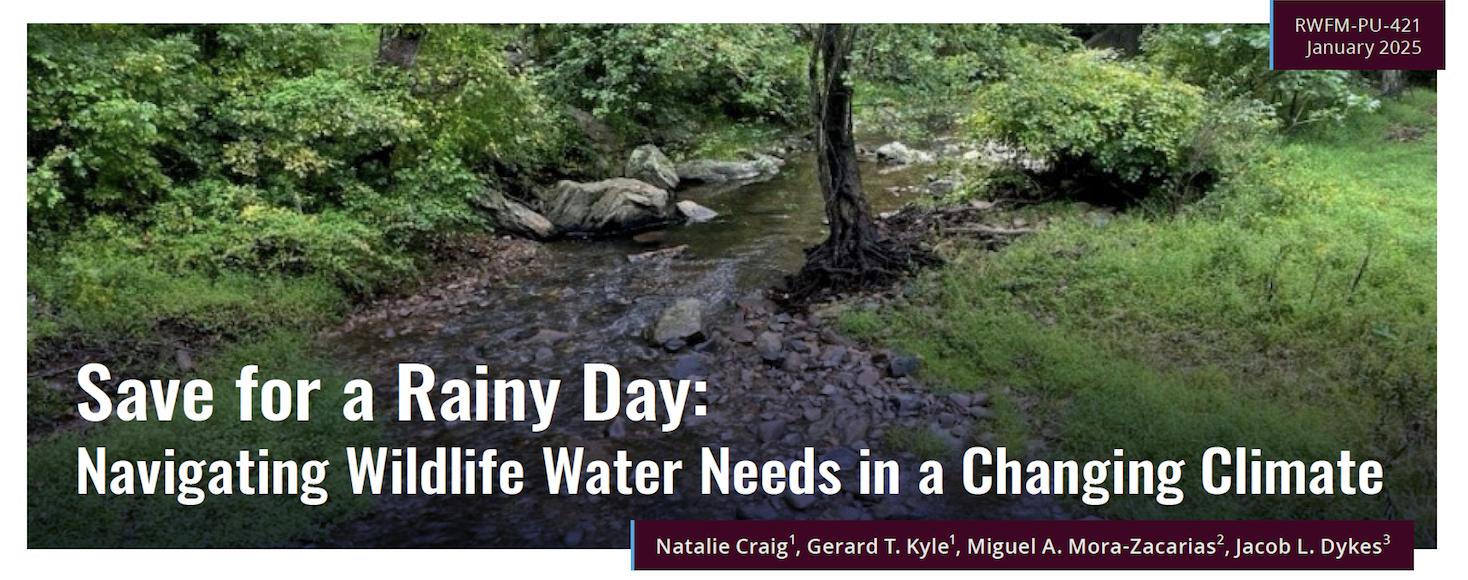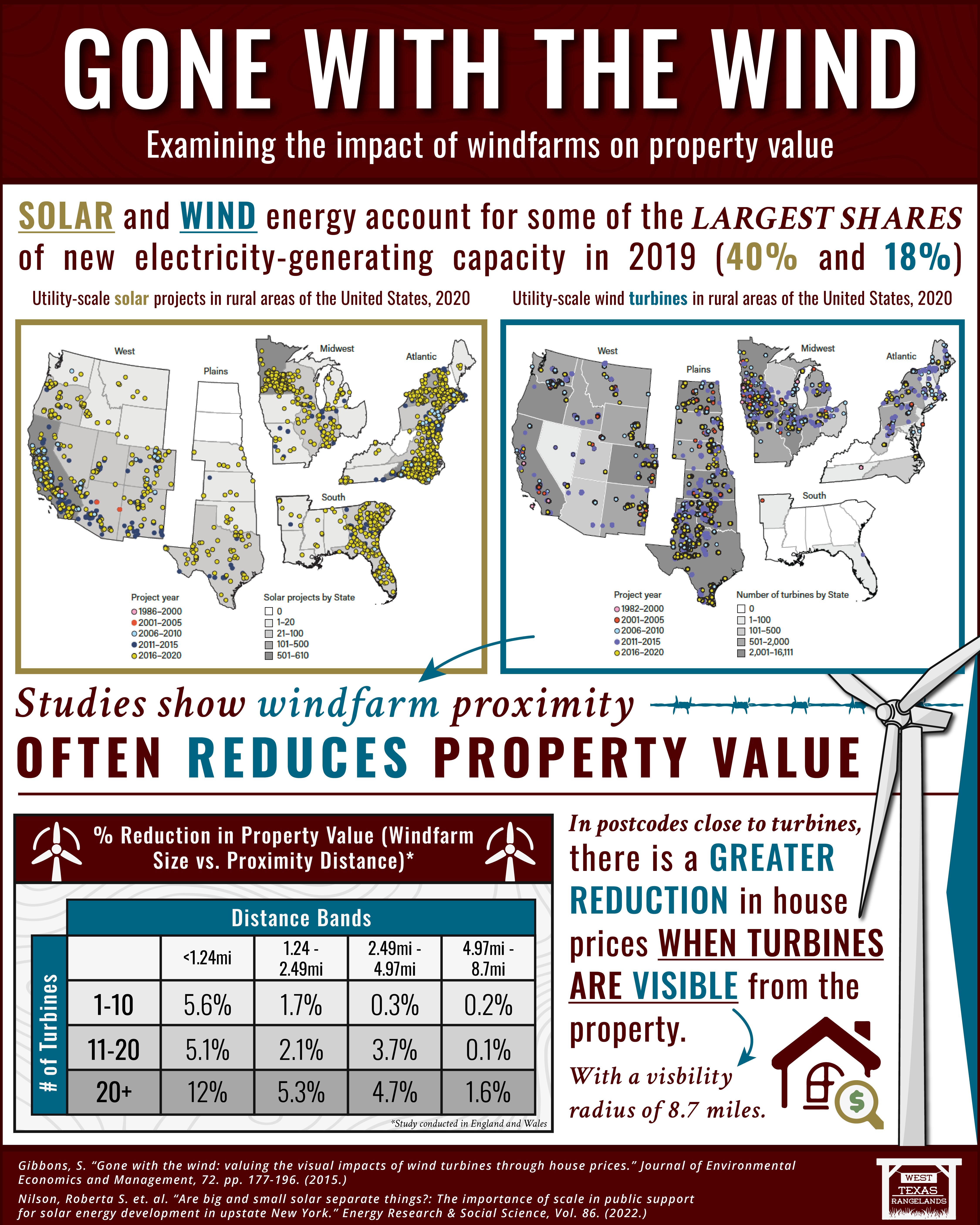 A fascinating new report from the amazing team at Texas A&M Natural Resources Institute sheds light on the changing landscape of Texas. Their sixth edition of a five-year study dives deep into population growth, land values, ownership patterns, and how land use is changing across Texas. The takeaways, reveal some significant trends that paint a picture of a state undergoing considerable transformation.
A fascinating new report from the amazing team at Texas A&M Natural Resources Institute sheds light on the changing landscape of Texas. Their sixth edition of a five-year study dives deep into population growth, land values, ownership patterns, and how land use is changing across Texas. The takeaways, reveal some significant trends that paint a picture of a state undergoing considerable transformation.
Save for a Rainy Day: Navigating Wildlife Water Needs in a Changing Climate
 Dr. Jacob Dykes and colleagues have recently published a factsheet exploring the diversity of wildlife using free water sources in arid environments in Far West Texas. As we know in that neck of the world, access to water is crucial. As extreme climatic events and variability intensify spurring flash droughts, dry spells, and extended drought conditions, the availability and predictability of water sources is becoming increasingly unpredictable and that much more of a priority.
Dr. Jacob Dykes and colleagues have recently published a factsheet exploring the diversity of wildlife using free water sources in arid environments in Far West Texas. As we know in that neck of the world, access to water is crucial. As extreme climatic events and variability intensify spurring flash droughts, dry spells, and extended drought conditions, the availability and predictability of water sources is becoming increasingly unpredictable and that much more of a priority.
[Read more…] about Save for a Rainy Day: Navigating Wildlife Water Needs in a Changing Climate
Gone With the Wind: Examining the Impact of Windfarms on Property Value
 Solar and wind energy development on rangeland is everywhere. They accounted for a whopping 40% and 18% of new electricity generation capacity in the United States in 2019, respectively. Inevitably, these projects often lead to habitat fragmentation, soil disturbance, and changes in hydrology, which can negatively impact native vegetation and wildlife species reliant on these landscapes. However, few ecological studies exist documenting plant community impacts, soil health dynamics, and wildlife habitat alterations, however, some studies conducted on wind and solar development have shown that proximity to wind farms can often reduce overall property values. This reduction is more significant when the wind turbines are visible from the property. The visual impact of wind turbines is a major factor in overall property value depreciation. Research suggests that the visibility radius for wind turbines can extend up to 8.7 miles.
Solar and wind energy development on rangeland is everywhere. They accounted for a whopping 40% and 18% of new electricity generation capacity in the United States in 2019, respectively. Inevitably, these projects often lead to habitat fragmentation, soil disturbance, and changes in hydrology, which can negatively impact native vegetation and wildlife species reliant on these landscapes. However, few ecological studies exist documenting plant community impacts, soil health dynamics, and wildlife habitat alterations, however, some studies conducted on wind and solar development have shown that proximity to wind farms can often reduce overall property values. This reduction is more significant when the wind turbines are visible from the property. The visual impact of wind turbines is a major factor in overall property value depreciation. Research suggests that the visibility radius for wind turbines can extend up to 8.7 miles.
[Read more…] about Gone With the Wind: Examining the Impact of Windfarms on Property Value
Blue Grama (Bouteloua gracilis)
 As stewards, let’s all just take a Christmas moment reflection and a deep breath of blue grama. Did you know that blue grama is the most common plant found throughout the mixed prairie? Even more impressively, blue grama possesses the most general distribution thriving as far north as Canada and as far south as Mexico.
As stewards, let’s all just take a Christmas moment reflection and a deep breath of blue grama. Did you know that blue grama is the most common plant found throughout the mixed prairie? Even more impressively, blue grama possesses the most general distribution thriving as far north as Canada and as far south as Mexico.
Cheatgrass in Texas Lower Rolling Plains
 What is Cheatgrass? Cheatgrass (Bromus tectorum), is an invasive annual species. This species poses a significant ecological threat to the Southern Great Plains of Texas, particularly in the Rolling Plains Region. Cheatgrass will displace native grasses such as sideoats grama (Bouteloua curtipendula), blue grama (Bouteloua gracilis) and little bluestem (Schizachyrium scoparium). These dominant, perennial, native grasses are key to maintaining soil stability, biodiversity, and forage quality (D’Antonio & Vitousek, 1992; Chambers et al., 2014).
What is Cheatgrass? Cheatgrass (Bromus tectorum), is an invasive annual species. This species poses a significant ecological threat to the Southern Great Plains of Texas, particularly in the Rolling Plains Region. Cheatgrass will displace native grasses such as sideoats grama (Bouteloua curtipendula), blue grama (Bouteloua gracilis) and little bluestem (Schizachyrium scoparium). These dominant, perennial, native grasses are key to maintaining soil stability, biodiversity, and forage quality (D’Antonio & Vitousek, 1992; Chambers et al., 2014).
70 Questions Important for Grassland Conservation
 Did you know that Grasslands are crucial to global food security, rangeland economies, carbon storage, and a variety of ecosystem services? Did you know that 31-43% of global lands are grasslands?
Did you know that Grasslands are crucial to global food security, rangeland economies, carbon storage, and a variety of ecosystem services? Did you know that 31-43% of global lands are grasslands?
A Management Priorities Working Group (MPWG) comprised of 11 individuals was tasked with identifying and reviewing the management related documents in order to:
1) Synthesize grassland management goals and challenges.
2) Identify questions and information needed to allow grassland managers to meet their goals within the context of climate change.
[Read more…] about 70 Questions Important for Grassland Conservation
Texas Producer Average Age Increases 1.2% to 59.9
 Every 5 years the USDA’s National Agricultural Statistics Service’s Census of Agriculture publishes and provides data at the U.S., state, and county levels. One of the metrics that is tracked in this census is the average age of agricultural producers.
Every 5 years the USDA’s National Agricultural Statistics Service’s Census of Agriculture publishes and provides data at the U.S., state, and county levels. One of the metrics that is tracked in this census is the average age of agricultural producers.
[Read more…] about Texas Producer Average Age Increases 1.2% to 59.9
Stability of C3 and C4 Grass Patches in Woody Encroached Rangeland after Fire and Simulated Grazing
 In the western portion of the southern Great Plains, grasslands are defined as “southern mixed”, with warm season or C4 mid-grasses being dominant and cool season or C3 short-grasses in less frequent densities. As woody plant encroachment increasingly dominates, the productive warm season C4 grasses begin to decline with less abundance on the landscape and even less productivity. Woody plant dominance also reduces plant diversity eroding heterogeneity in the mixed-grass prairie. Recently, researchers measured the effects of various combinations of spring clipping (mimicked cattle grazing) and prescribed fire treatments over an 8 year period on Texas wintergrass and buffalograss with the overall objective of reducing Texas wintergrass abundance and increasing warm season C4 mid-grass species and diversity.
In the western portion of the southern Great Plains, grasslands are defined as “southern mixed”, with warm season or C4 mid-grasses being dominant and cool season or C3 short-grasses in less frequent densities. As woody plant encroachment increasingly dominates, the productive warm season C4 grasses begin to decline with less abundance on the landscape and even less productivity. Woody plant dominance also reduces plant diversity eroding heterogeneity in the mixed-grass prairie. Recently, researchers measured the effects of various combinations of spring clipping (mimicked cattle grazing) and prescribed fire treatments over an 8 year period on Texas wintergrass and buffalograss with the overall objective of reducing Texas wintergrass abundance and increasing warm season C4 mid-grass species and diversity.
Influence of Environment and Stage of Growth on Honey Mesquite Response to Herbicides
 Honey mesquite varies widely in its response to herbicides. Previous research demonstrates most effective treatments have occurred about 50 to 90 days after the first leaves appear in the spring when they are fully formed and dark green (Bovey and Mayeux, Jr. 1981; Jacoby and Meyers 1983; Meyer et al., 1986). More recently, triclopyr has been found to be effective for control of honey mesquite (Bovey and Mayeux, Jr. 1981; Jacoby et al., 1981; Jacoby and Meadors 1983). Also, clopyralid has been found to be highly effective for controlling honey mesquite (Bovey and Mayeux, Jr. 1981; Jacoby et al., 1981).
Honey mesquite varies widely in its response to herbicides. Previous research demonstrates most effective treatments have occurred about 50 to 90 days after the first leaves appear in the spring when they are fully formed and dark green (Bovey and Mayeux, Jr. 1981; Jacoby and Meyers 1983; Meyer et al., 1986). More recently, triclopyr has been found to be effective for control of honey mesquite (Bovey and Mayeux, Jr. 1981; Jacoby et al., 1981; Jacoby and Meadors 1983). Also, clopyralid has been found to be highly effective for controlling honey mesquite (Bovey and Mayeux, Jr. 1981; Jacoby et al., 1981).
North American Grasslands Conservation Council – Upcoming Bill
 Did you know that grasslands provide vital habitat for a multitude of species which represent the lifeblood of local and regional economies?? That the maintenance of health populations of grasslands species and working lands are critical for rural economies? That grassland and rangeland ecosystems provide essential and significant habitat for mammals, pollinators, reptiles, and other wildlife? Roughly 358,000,000 acres or 85% of the United States is privately owned and serves as an important habitat for 29 grassland bird species!
Did you know that grasslands provide vital habitat for a multitude of species which represent the lifeblood of local and regional economies?? That the maintenance of health populations of grasslands species and working lands are critical for rural economies? That grassland and rangeland ecosystems provide essential and significant habitat for mammals, pollinators, reptiles, and other wildlife? Roughly 358,000,000 acres or 85% of the United States is privately owned and serves as an important habitat for 29 grassland bird species!
[Read more…] about North American Grasslands Conservation Council – Upcoming Bill